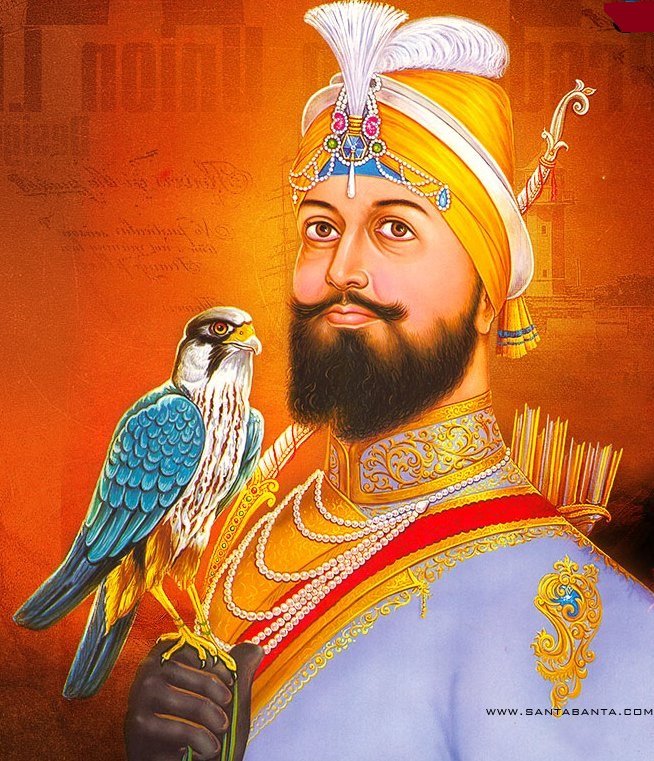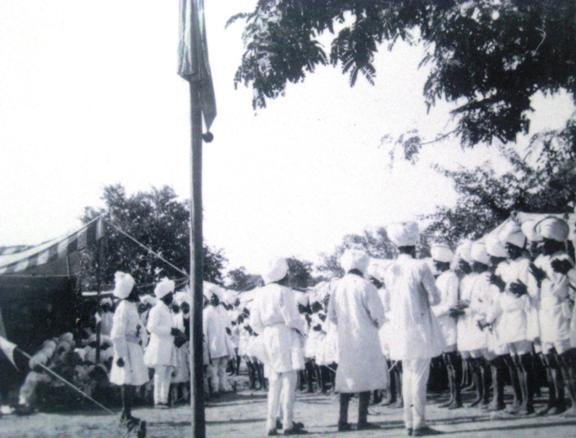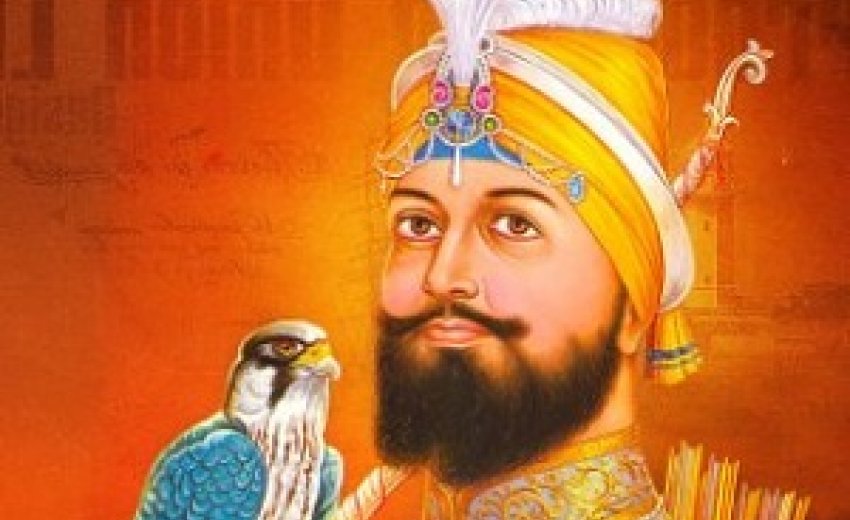A nation of true warriors
 Sikhs are known as best fighters in the World. Indian British Army had large number of Sikhs in their Army. During Indian mutiny Sikh helped British to put mutiny down. Sikhs were considered backbone of British Power in India. During World War 1 and World War II over ONE MILLION Sikhs fought, over 80,000 died to gain world freedom. The freedom we live in now, is earned by our ancestors. Wherever we live in world, our Turban is accepted by most military and police force. Our turban is accepted because we earned the right to wear it and our ancestors earned it during both world wars. Sikh soldiers won most Victoria Crosses in the British Indian Army. The Indian Army has large number of Sikh Soldier. They were back bone of Indian victories in major conflicts. Being a Solider is in our blood. We are the Saint Soldiers. We do not get intimidated, neither we intimidate any one. Our supreme commander is God itself. This belief is given to us by founder of Sikh Brotherhood "Guru Gobind Singh". Be a proud Sikh; wear your turban with pride. Where ever you are serving your country and community.
Sikhs are known as best fighters in the World. Indian British Army had large number of Sikhs in their Army. During Indian mutiny Sikh helped British to put mutiny down. Sikhs were considered backbone of British Power in India. During World War 1 and World War II over ONE MILLION Sikhs fought, over 80,000 died to gain world freedom. The freedom we live in now, is earned by our ancestors. Wherever we live in world, our Turban is accepted by most military and police force. Our turban is accepted because we earned the right to wear it and our ancestors earned it during both world wars. Sikh soldiers won most Victoria Crosses in the British Indian Army. The Indian Army has large number of Sikh Soldier. They were back bone of Indian victories in major conflicts. Being a Solider is in our blood. We are the Saint Soldiers. We do not get intimidated, neither we intimidate any one. Our supreme commander is God itself. This belief is given to us by founder of Sikh Brotherhood "Guru Gobind Singh". Be a proud Sikh; wear your turban with pride. Where ever you are serving your country and community.
Sikh Anthem
Deh Siva bar moh ehe, shubh karman to kabahu na taru
Na dare aar seo jab jah lare, nischay kar aapne jeet kare
Aar sikh ho aapne hi man ko, eh lalach hau gun teo uchroo
Jab aav ki aaun nidhan banae, aat hi runn me tab joojh maroo
- Guru Gobind Singh, 10th Guru of the Sikhs
(pp 99 Dasam Granth)
Grant me this boon O Lord, Never shall I shirk from a good deed
Neither be afraid of a righteous fight and walk with determination towards victory
Listen O Sikhs to your own minds, rise above its petty greed and hubris
And when the final call is made, embrace your end in the battlefield
The hymn is part of Guru Gobind Singh Ji's Chandi Charitar Ukti Bilas, a section of Sri Dasam Granth. While this was and is still at times used more of battle cry to rouse up the troops, it has a greater meaning in living one's life in my opinion.
All the situations that we face in our daily lives create certain impressions on our minds. If looked carefully, it is these very impressions that govern how we react to situations and feel happy, sad etc. Now on the battlefield of the mind, always be aware of these enemies and ask the Akal Purukh (Waheguru or Lord) to help us do the right thing, be true to our nature. Through this, we can win over the daily battles and work towards the real purpose in our lives and walk without fear to the end.
This quotation written in the Jang Namah (battle chronicles) by Quzi Nur Mohammed in 1765, He was a staunch enemy of the Sikhs but he goes into a rosary of praise when he goes into defining qualities of Sikh Warriors.
" … If you cherish the desire of learning the art of war, face them on the battle field. When they hold their mighty sword, they gallop from Hind to Sind. Nobody however strong and wealthy dare oppose them. If their sword struck a coat of mail, the coat itself becomes the enemy's shroud. Each and every one of them looks like massive boulders of rock. In a grandeur, each one of them excels fifty men…"
Sikh warriors developed these qualities through hard physical and mental training; They spent their spare time in meditation, learning Shastr Vidya (Sikh Martial Art) and the main icing on the cake is getting initiated (taking Amrit) which stirred valor and bravery in them. In fact, this was a pre-requisite before they were recruited in the forces to fight others.

Guru Gobind Singh's famous words;
Chirian to mein baaz tudaun.
Gidran to mein sher banaun.
Sawa lakh se ek ladaun.
Tabe Gobind Singh Naam kahaun.
(It is when I make sparrows fight hawks and
mould 'giddars' into lions,
that I am called Gobind Singh).
So much admiration has been excited by the distinguished conduct of the Sikh regiments of the Indian Army in the Frontier campaign and in the both World Wars that some account of the origin of these fine fighting men may be found interesting and an eye-opener to the ignorant. To those unacquainted with Indian history it may be difficult to realise that the Sikh soldiers were, so brave in the charge on in the assault, so steady in retreat, so devoted in spite of race and creed to his English officer, should be the representative of the fanatical and savage foemen who, but one hundred fifty years ago, shook the power of Great Britain in half a dozen bloody battles, and earned almost as much infamy by the cruelty with which they treated the wounded as honour by the tenacity of their resistance. This is clearly exemplified in the Battle of Saragarhi by 21 Sikh soldiers. Jagmeet Singh Samundri, a filmmaker of the Rise of Khalsa and Martyrs has researched and he confirms following his interviews that there were 22, and he has met the 4th Sikh Regiment commanders which was 36 Sikh regiment at that time, the name of the 22nd was Dad Singh, a sweeper The London Gazette mentioned the names of 21 Sikhs (by individual). It is mysterious that Dad Singh's name has been omitted. Late Major Des Vouex testimony. Major des Vouex wife was also treating the wounded. And she also mentioned 21 Sikhs. The Museum in Ferozpur mentions the 21 Sikhs and General William Lockhart also mentioned in his book 'tirah campaign' about 21 gallant Sikhs.
The evolution of the Sikh soldier dates, however, from a much earlier period, and its history is very strange. The Sikhs, it must be remembered, were in the beginning no nation, but merely a weak and persecuted religious community, formed by a succession of priestly rulers, known as the Ten Gurus, from the Hindus who desired to free themselves from the pretensions of the Brahmins, and to find in a reformed communion a purer morality and that religious equality which had been taken from them by the development of the system of caste.
It is clear that Guru Nanak Dev Ji started the Herculean task of nurturing the Sikhs to become the bravest soldiers the world has ever known. The successive Gurus tendered the enviable task. The concept of Miri-Piri (temporal and spiritual) by Guru Hargobind was unique but the final sophistication of the Miri-Piri came when Guru Gobind Singh, held in his hand the two swords which he had merged into the double-edged sword called the Khanda. Out of this Khanda, the Khalsa took amrit (ambrosial nectar) on the unique day of Vaisakh 1699. With this the fructification of Guru Nanak's mission was complete; thereafter, the Khalsa was ready to play the Game of Love in his role as a Sant-Sepahi, the saint-soldier.
"Jo to praym khaylan ka chaao, sir dhar talee galee mayree aao."
(Those who wish to play the game of love (follow Sikhi way of life), come to me with your head in your palm.)
"It maarag pair dhareejai, sir deejai kaan na keejai."
(If you wish your feet to travel this path, don't delay in accepting to give your head.)
This being an account of the Sikh soldier, it must suffice to say that their national religion dates from the period in the life of Nanak, its founder, when (as his disciples believe) he was carried by angels into the Divine Presence, and received a mandate to preach the doctrine of the true God on earth.
Nanak was born in the year 1469 at Rae BoekiTalwandi (now known as Janam Asthan Nankana Sahib) near the city of Lahore, and had attained manhood before this miraculous occurrence, which took place, therefore, towards the end of the fifteenth century. Passing briefly over the gradual increase in numbers and strength of the Sikhs, we arrive, some two centuries later, at Gobind Singh, the Tenth and last of the Gurus, who took upon himself the task of uniting the scattered disciples of his creed into a military nation. With this object Gobind Singh resuscitated the disused initiation rite of the Sikhs, the administrator and the recipient of the initiation both shouting to the assembled disciples the battle-cry, as it really was rather than a profession of faith, "Waheguru Ji Ka Khalsa", which may perhaps be best interpreted as " Victory to the belongings (or followers) of God." Gobind Singh was assassinated in the year 1708, by which time the Sikhs had become a powerful and war-like race, strongly united by the consciousness that by unity and vigour alone could they hope to hold their own against the surrounding power of Islam ; but they had yet to await the coming of the man who was to weld their confederacies into, to form for them a policy, and, by long years of war and conquest, to acquire for them a kingdom whose limits should be respected by the Afghans on the North, and by the all-devouring English on the South. At length, in the year 1780, was born at Gujranwala, Ranjit Singh, destined to become a great ruler of men, and to be deemed worthy by many of the designation of the Napoleon of the East. Ranjit Singh was the son of Mahan Singh, chief of one of the least powerful of the twelve confederacies in which the Sikhs were at that time embodied, and, succeeding his father at the age of eleven years, devoted a persistent and unswerving ambition to the task of gradually bringing confederacy after confederacy under his rule, until he became the absolute monarch of the Sikhs and of the kingdom of the Panjab. By the year, 1809 Ranjit Singh, though still far from the fulfilment of his ambition, he become the most powerful of the Sikh chieftains, and it was in that year that he learned from a trifling incident the value of the European system of military discipline.
The effect of the Anglo-Sikh Wars on the British was of a different nature. They saw an opportunity to make use of the bravery of the Sikh soldiers for the expansion and security of their colonial power. After The Battle of Chillianwala, an impression was created that the Sikhs made the finest soldiers and if employed in the British forces and with good leadership, they could be of great advantage in the expansion of the British Empire in Africa and in other parts of the world. At this time a number of British generals had written glowing reports of Sikh valour and courage.
"The major reasons for our defeat are Sikhs. We are simply unable to do anything before them despite our best efforts. They are very daring people and are fond of martyrdom. They fight courageously and are capable of defeating an army much bigger than them."
On 3rd December 1971 we fiercely and vigorously attacked the Indian army with infantry brigade near Hussainiwala border. This brigade included Pakistan army's Punjab regiment together with the Baloch regiment. Within minutes we pushed the Indian army quite far back. Their defense posts fell under our control. The Indian army was retreating back very fast and the Pakistani army was going forward with great speed.
Our army reached near Kausre-Hind post (Kasure). There was small segment of Indian army appointed to defend that post and their soldiers belonged to the Sikh Regiment. A few number of the Sikh Regiment stopped our way forward like an iron wall. They greeted us with the ovation (Slogan) of 'Bolé-so-Nihal' and attacked us like bloodthirsty, hungry lions and hawks. All these soldiers were Sikhs. There was even a dreadful hand-to-hand battle. The sky filled with roars of 'Yaa Ali and Sat Sri Akal'. Even in this hand-to-hand fighting the Sikhs fought so bravely that all our desires, aspirations and dreams were shattered.
In this war Lt. Col. Gulab Hussain was killed. With him Maj. Mohammed Zaeef and Capt. Arif Alim also died. It was difficult to count the number of soldiers who got killed. We were astonished to see the courage of those, handful of Sikh soldiers. When we seized the possession of the three-story defense post of concrete, the Sikh soldiers went onto the roof and kept on persistently opposing us. The whole night they kept on showering fires on us and continued shouting the loud ovation of 'Sat Sri Akal'. These Sikh soldiers kept on the encounter till next day. Next day the Pakistani tanks surrounded this post and bombed it with guns. Those, handful of Sikhs got martyred in this encounter while resisting us, but other Sikh soldiers then destroyed our tanks with the help of their artillery. Fighting with great bravery they kept on marching forward and thus our army lost its foothold.
Alas! A handful of Sikhs converted our great victory into big defeat and shattered our confidence and courage. The same thing happened with us in Dhaka, Bangladesh. In the battle of Jassur, the Singhs opposed the Pakistan army so fiercely that our backbone and our foothold were lost. This became the main important reason of our defeat; and Sikhs' strength, safety and honour of the country, became the sole cause of their victory.
General Bardwood
"I will not be slightly worried or reluctant to leave my wife and young daughter under protection of any Sikh soldier." (cited in Gurmat Prakash Amritsar, Feb., 1997)
Lord Mountbatten (India's Last British Viceroy)
"Guru Nanak was a great poet, philosopher and saint. His teachings are of universal application and his message of love, service and sacrifices will continue to inspire coming generations." (Excerpt from speech in London on Guru Nanak's Quincentenary)
Martial India, F.Yeats-Brown, 1945:
"A remarkable people, the Sikhs with their Ten Gurus ( Prophets), 5 distinguishing marks ( 5K's), and their baptismal rite of water (Amrit) stirred with Steel; a people who have made history, and will make it again"
References:
1) Macmillan's Magazine 30th April 1898
2) Saluting Sikh Soldiers of World Wars I & II ( Surjan Singh)
3) Sikh Soldiers/ Facebook
